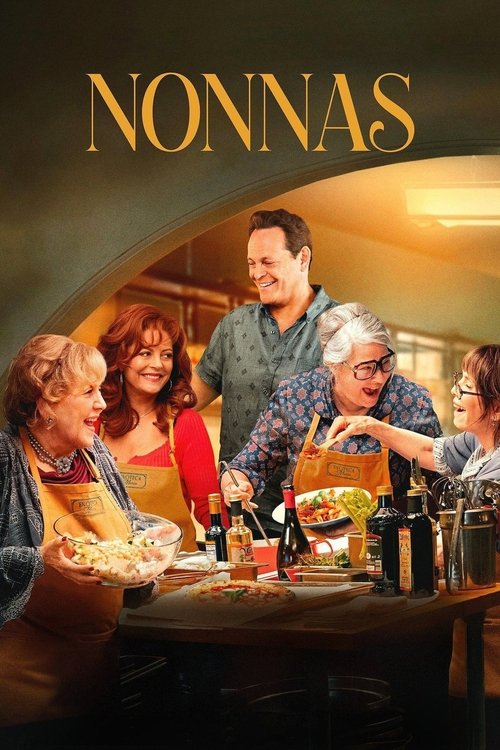
Ask Your Own Question
What is the plot?
The film opens with a flashback to a kitchen in 1970s Brooklyn. A boy named Joe Scaravella stands on a stool at the counter while his mother, Maria, and his grandmother--his nonna--move around him, stirring pots and shaping dough. Maria instructs him on how to roll pasta while the nonna corrects his grip and sprinkles flour over the wooden board. Relatives crowd the small apartment for a Sunday meal; someone puts on a record and people begin to dance in the cramped living room. The camera lingers on the warmth of hands passing plates and on the laughter as sauce stains a sleeve. The scene closes on the three generations working and celebrating together.
Decades later, Joe sits alone in the same apartment, now diminished by absence. His mother, Maria, has died; the film does not depict anyone killing her and provides no on-screen cause of death. He keeps living among the smells and utensils that once defined their family life, attempting to replicate her recipes, teaching himself to shape meatballs and simmer sauces from memory. He continues to try to recreate his nonna's famed Sunday gravy but cannot match its flavor no matter how many pots he simmers.
Joe receives a visit from Roberta, a longtime friend of his mother, at an assisted living facility. Roberta presses a sealed envelope into his hands: a letter from Maria. Joe tucks it away without opening it. He carries the sealed paper home and lays it between plates and recipe cards, avoiding it because he fears that opening it will be the final surrender to his grief.
Bruno, Joe's childhood friend, and Bruno's wife, Stella, come for dinner at Joe's apartment. Bruno and Stella sit at the table as Joe prepares pasta, tossing noodles with tomato sauce. Bruno remarks on Joe's fixation on the past, and Stella urges Joe to use the payout from Maria's life insurance to do something for himself. Stella says he should invest it instead of sitting in the apartment alone. Bruno and Stella leave after dinner but their counsel lingers with Joe.
Searching for connection to the life he remembers, Joe drives to Staten Island and wanders through the open-air market he used to visit with Maria and his nonna. He passes vendors selling olives, fennel, and old photographs. Among the stalls, he notices Olivia, a woman who used to be his prom date in high school, shopping with her neighbor Antonella. Olivia is wearing a wedding ring and carries herself with quiet reserve. Later conversation reveals Olivia's husband has died; the film provides no cause of death and shows no one responsible for it. The brief exchange between Joe and Olivia rekindles memory and curiosity.
While walking past a shuttered restaurant on Staten Island, Joe's eye catches the faded sign and the empty dining room through dusty windows. He imagines the space filled with chatter and sauce-scented air. On impulse he decides to lease the place and open a restaurant he names Enoteca Maria, dedicating it to his mother. He conceives a unique concept: the kitchen should be staffed by nonnas who cook the food of their own childhoods so customers will taste family recipes from many traditions. He calls Bruno and asks him to serve as contractor; Bruno agrees and begins work on the renovation.
Joe posts an ad on Craigslist seeking "nonnas" to cook in his restaurant. Applicants begin to arrive in a chaotic day of auditions. Roberta--Maria's old friend--shows up after Olivia persuades Antonella to come. An older woman named Teresa barges in amid a heated argument, insisting she can cook anything. Gia, Maria's former hairdresser, whom Joe persuades to provide desserts, accepts as well; the film identifies Gia as a hairdresser who also prepares pastries for the menu and is played by Susan Sarandon. Each of the women prepares a dish: Antonella offers a simple tomato and basil sauce, Roberta makes capuzzelle (a traditional stuffed sheep's head) with deliberate precision, Teresa insists upon a spicy ragù, and Gia arranges delicate pastries. Each woman throws her personality into the food and Joe, unable to resist the living network of recipes, hires them all.
The nonnas clash at first. Antonella and Teresa trade barbs about techniques; Roberta insists on exacting measurements while Gia laughs them off and speaks of style and presentation. Tension grows in the kitchen: the women come from different regions and temperaments, and they spar while they cook. To relieve the strain, Gia invites the other women to her salon for hair and makeup, arranging a private pampering session. The salon scene transforms the group. She treats each woman with respect and glamour; around mirrors and hair dryers they divulge stories and begin to bond. Their quarrels dissolve into laughter. They emerge closer, with a shared sense of purpose for the restaurant's menu.
During a chaotic prep session in Enoteca Maria's kitchen, Roberta prepares her capuzzelle. As she works, a flour-and-sauce food fight erupts among the cooks: someone flicks a smear of sauce, another retaliates with a handful of flour, and utensils clatter. A pan shifts on the stove and Roberta drops the sheep's head into a hot oven. The oven's wiring, stressed by misuse and age, sparks; a small flash becomes a larger flame when a pot tips. An explosion occurs when the oven combusts, and the kitchen fills with smoke. Joe rushes into the smoke-filled room, coughing as the fire alarms shriek. Firefighters arrive and extinguish the blaze; the inspector examines scorched tiles and charred equipment. The inspector refuses to grant the certificate of occupancy because of the recent fire damage and because the building's previous histories include earlier violations. He tells Joe that it could be a year before another inspection is possible. The inspector's brusque language and bureaucratic reply stall Joe's opening.
Bruno and Joe argue in the damaged dining room, tempers flaring. Joe lashes out, blaming Bruno for mismanaging the renovation timeline. In anger Joe kicks Bruno out of the job and out of the building. Bruno leaves, shutting the door behind him, and walks away with his shoulders hunched.
Joe attempts to shoulder the rebuilding alone but soon discovers Bruno has already made a private sacrifice. He apologizes and goes to Bruno's home, where he finds Bruno has sold the classic car he had inherited from his father in order to contribute funds to the restaurant. Bruno hands Joe the check for the proceeds and insists that he did it because he believes in Joe's idea. Joe sees the model car in Bruno's garage is gone and realizes the depth of Bruno's commitment. Touched and ashamed by his earlier outburst, Joe reconciles with Bruno. They rejoin the reconstruction work with renewed determination.
Meanwhile, Olivia--who is a lawyer--intervenes in the bureaucratic maze. She researches the fire inspector and uncovers a pattern of unethical practices, backlogged inspections, and ties to local vendors. Olivia confronts him and compels him to conduct another inspection right away. She threatens legal action for undue delay and improper procedure. The inspector, unsettled by her questions and unwilling to face exposure, agrees to reinspect. He walks through the restaurant, checks the fire suppression system, vents, and wiring, and after a thorough examination reluctantly passes Enoteca Maria. The team breathes a collective sigh of relief and prepares to open.
As the restaurant prepares for its debut, Gia organizes makeovers for the nonnas to boost their confidence. The women rehearse greeting diners and telling the stories behind their recipes. They lay out menus that list the names of their grandmothers and the hometowns where the recipes originate. The dining room is swept, tables are dressed with white linens, and the front windows are polished to present the affect of a classic neighborhood eatery.
Opening night arrives and a thunderstorm sweeps across Staten Island. Rain drums on the awning and lightning flashes over empty streets. Patrons who had considered coming turn away in the storm. The crowd at the door is small: Bruno and Stella sit in the front booth, waiting with patience and empty plates. Joe watches the rain from the kitchen entryway, heart sinking as hints of equipment he once feared--an empty bar, untried servers--loom in the candlelight. He and the nonnas work the service as if the dining room were packed, plating courses with practiced hands despite the hushed room.
Business remains sparse in the ensuing weeks. Antonella discovers that a major vendor at the open-air market has been speaking against Enoteca Maria to neighborhood shoppers; he tells locals that the restaurant is an outsider trying to profit off Staten Island traditions and encourages them to boycott it. Customers who had been curious become suspicious. The restaurant's name struggles to spread beyond the limited circle of friends and loyal helpers.
Joe, desperate to attract customers, seeks attention from Edward Durant, a well-known restaurant critic, and arranges to have him review Enoteca Maria. Durant replies that he covers fine restaurants in Manhattan and has a months-long booking. He declines to come. Without the critic's endorsement, the restaurant's exposure remains minimal.
After weeks of little or no revenue and unpaid bills piling up, Joe makes the painful decision to close the restaurant. He signs the paperwork and schedules a final dinner, inviting friends, family, and the nonnas' own communities as a farewell celebration. On the appointed Sunday night the tables fill with the gathered acquaintances who came because they loved the cooks or owed a kindness or wanted to taste the stories. The nonnas and staff cook through the night; the dishes arrive in succession--Antonella's simple pasta with fresh basil, Roberta's capuzzelle presented with tactile ceremony, Teresa's ragù rich and spicy, and Gia's desserts arrayed on a long platter. Laughter fills the dining room. People stand to applaud the four cooks and their kitchen team. The assembled crowd rises, clapping and cheering; the nonnas come out of the kitchen to accept the applause, lifting their aprons and smiling openly at the recognition.
After the final plates are cleared and the diners have left, Joe sits alone in the quiet restaurant with the envelope from his mother. The evening's warmth loosens the tight knot in his chest. He breaks the wax seal and unfolds Maria's letter. Inside he finds a set of handwritten recipes that Maria copied from their family's traditions--detailed lists of ingredients, notes on timing, and the precise method for the elusive Sunday gravy that Joe had been unable to recreate. The letter includes instructions and small remarks in the margins. Joe follows the recipe later that night, stirring a pot as the nonnas watch him from the prep kitchen, and finally achieves the taste he had been chasing for years.
A few days after the closure, Bruno arrives at Joe's apartment with a local newspaper. He shows Joe a review. One of the guests at the final dinner had been an undercover critic employed by Edward Durant; Durant had sent the critic incognito to investigate. The critic's write-up appears in the paper and praises the authenticity and heart of Enoteca Maria. The review highlights the nonnas' cooking and the emotional resonance of the concept. Within days, the restaurant sees a rush of customers responding to the article. Patrons queue outside; booths fill; plates are served and emptied again.
Business rebounds and Enoteca Maria thrives. Joe earns enough to repay Bruno's sacrifice and to buy back the classic car Bruno had sold. The film shows Joe handing Bruno the keys and the purchase documents; Bruno smiles and climbs into the driver's seat, the car idling with a familiar rumble. The nonnas step out of the kitchen to mingle with customers and dance in the dining room. Olivia, who has been present and supportive through the ordeal and who now moves her wedding ring from her left hand to her right, joins Joe on the dance floor. They dance together amid the applause of patrons and the warm light of the restaurant, marking the beginning of a new relationship.
The film closes with shots of the nonnas working in the kitchen alongside Joe, plates moving to and from the pass, and diners smiling as they eat. A final sequence during the credits shows real-life footage of Enoteca Maria, noting that the restaurant has been open for fifteen years with nonnas from around the world cooking in its kitchens. The last images depict the restaurant's front on a bustling street, guests coming in, and older women stirring pots in the kitchen as the screen fades to black.
What is the ending?
The movie Nonnas (2025) ends with Joe successfully opening and running the restaurant Enoteca Maria, staffed by several Italian grandmothers ("nonnas") who bring their authentic family recipes and culinary traditions to life. Despite initial challenges, the nonnas bond deeply as a chosen family, and Joe finds closure and connection to the memory of his mother and grandmother through this communal space of food and love.
Expanded, scene-by-scene narration of the ending:
The final act begins with Joe, still mourning his mother's recent death, deciding to honor her memory by using her life insurance money to pursue a dream inspired by his childhood. He recalls the warmth of the kitchen where his mother, Maria, and his grandmother lovingly cooked traditional Italian dishes, but he struggles to recreate the elusive taste of his grandmother's Sunday gravy.
Joe visits a closed restaurant space on Staten Island, determined to establish his vision there. He enlists his best friend Bruno's help to renovate the place into a classic Italian eatery named Enoteca Maria, after his mother. Although the local community at first doubts the idea, Joe's passion drives the project forward.
He recruits a diverse group of nonnas, including his mother's best friend Roberta, a neighbor named Antonella, a former hairdresser named Gia, and Teresa, who applies on a whim. These women initially clash due to their varied personalities and regional backgrounds, reflecting slight cultural differences between northern and southern Italian heritages.
Their tentative interactions come to a turning point when Gia invites them for a private pampering session at her salon. This moment, filled with warmth and camaraderie, breaks down walls and fosters genuine friendship among the nonnas.
As the restaurant opens, it becomes more than just a business--it is a place where these elderly women, often marginalized and forgotten, find purpose, pride, and a renewed sense of family. Joe treats them with respect and kindness, even when their spirited antics lead to operational challenges.
Meanwhile, through shared cooking and conversations, Joe reconnects deeply with his roots. The kitchen becomes a living tribute to the women who shaped him, and the community gathers, finding comfort in the food and in the family-like bond among the nonnas and Joe.
In the final scenes, the restaurant thrives, and the bond among Joe and the nonnas is palpable. They share laughter, meals, and memories, embodying the film's central message about the power of chosen family, heritage, and honoring those who came before. Joe finally opens the letter from his mother's best friend Roberta, symbolizing acceptance and closure to his grief, as he fully embraces this new chapter of life inspired by love and tradition.
Who dies?
In the 2025 movie Nonnas, there is no indication from the available information that any characters die during the film. The storyline centers on Joe Scaravella, who opens a restaurant staffed by Italian grandmothers ("nonnas") to honor his late mother and create a community space. The plot focuses on themes of family, memory, and community rather than character deaths.
Specifically, the film recounts Joe's grief for his mother, but she is already deceased before the main storyline begins, and her passing motivates Joe's actions. There are no reports of deaths occurring among the main characters, including the nonnas who cook at the restaurant or Joe's family and friends. The film emphasizes connection and healing over loss during its narrative arc.
Therefore, no characters die in the events depicted within Nonnas itself.
Is there a post-credit scene?
The movie "Nonnas" (2025) does not have any mention of a post-credit scene in the available search results. The film's ending focuses on Joe's emotional journey as he opens and ultimately saves his restaurant, Enoteca Maria, with the support of real-life grandmothers cooking in the kitchen. The final scenes show Joe hosting a goodbye party and then discovering that a food critic published a positive review, giving him renewed hope. The film closes with Joe visualizing his late mother and grandmother working alongside the nonnas, symbolizing the honoring of family and culture, but no post-credit or after-credits scenes are indicated.
Therefore, it can be concluded that "Nonnas" does not have a post-credit scene. The story concludes fully within the main feature without any additional scenes after the credits.
What are the backgrounds and personalities of the nonnas who cook at Joe's restaurant?
The nonnas come from different Italian backgrounds and have distinct personalities. Roberta is from Sicily, Antonella is from Bologna, and Teresa is from the Bronx. Initially, they clash due to their different backgrounds but eventually bond and become friends, especially after a pampering session at Gia's salon. Each nonna brings her own family recipes and stories to the restaurant, contributing to its unique atmosphere.
How does Joe's relationship with his mother and nonna influence his decision to open the restaurant?
Joe's deep connection to his mother and nonna, especially through the family recipes and memories of cooking together in the kitchen, inspires him to open the restaurant. After his mother's passing, he tries to recreate the dishes they used to make but struggles to replicate his nonna's Sunday gravy. This emotional bond and desire to honor their memory motivate him to create Enoteca Maria, a restaurant staffed by nonnas to bring authentic, heartfelt Italian food to the community.
How does Joe's relationship with his mother and nonna influence the restaurant?
Joe's deep connection to his mother and nonna, especially through their cooking and family recipes, inspires him to open the restaurant. He tries to recreate the dishes they used to make, particularly struggling to replicate his nonna's Sunday gravy. The restaurant is a tribute to their memory and the comfort their food provided, symbolizing family and heritage.
What challenges does Joe face in opening and running the restaurant?
Joe faces resistance from Staten Island locals who are skeptical about his restaurant staffed by nonnas. He also lacks experience in starting and operating a restaurant, which causes doubts from his friend Bruno. Additionally, the nonnas initially clash due to their different backgrounds, and their antics sometimes land the restaurant in hot water. Despite these challenges, Joe perseveres with the help of friends and the nonnas themselves.
How do the nonnas and Joe's team develop their relationships throughout the film?
The nonnas, initially from different backgrounds and somewhat at odds, grow closer after bonding activities like a pampering session at Gia's salon. Joe treats the nonnas with patience and respect, and over time, they consider themselves a family. The restaurant becomes a source of purpose and pride for the nonnas, improving their lives and creating a chosen family dynamic.
Is this family friendly?
The movie Nonnas (2025) is broadly considered family-friendly and heartwarming, focusing on themes of family, culture, food, and community, reflecting the true story behind an Italian-American restaurant. It emphasizes positive messages such as love, forgiveness, and the importance of generational bonds, making it suitable for most audiences, including families.
However, there are some elements to consider for children or sensitive viewers:
- Mild romantic elements and some discussions about feelings and relationships occur but without explicit content.
- Light foul language and some suggestive material are present, though not excessive.
- A homosexual character appears, treated respectfully within the story.
- Alcohol consumption is shown throughout, including brief scenes of drunkenness.
- The film includes a flashback of a funeral and deals with grief, which might be emotionally sensitive for some children or sensitive viewers.
- Food fights and some humorous insults between characters, which are playful and good-natured in tone.
Overall, caution is suggested for older children and sensitive adults, primarily due to mild language, alcohol use, and emotionally mature themes like grief and loss. There are no reports of graphic violence or explicit adult content that would make it inappropriate for families with younger kids, so it could be suitable with parental guidance depending on the child's sensitivity.
In summary, Nonnas is predominantly a comforting, family-centered film with minimal potentially objectionable content, mostly relating to moderate language, brief alcohol use, and emotional themes.



























































